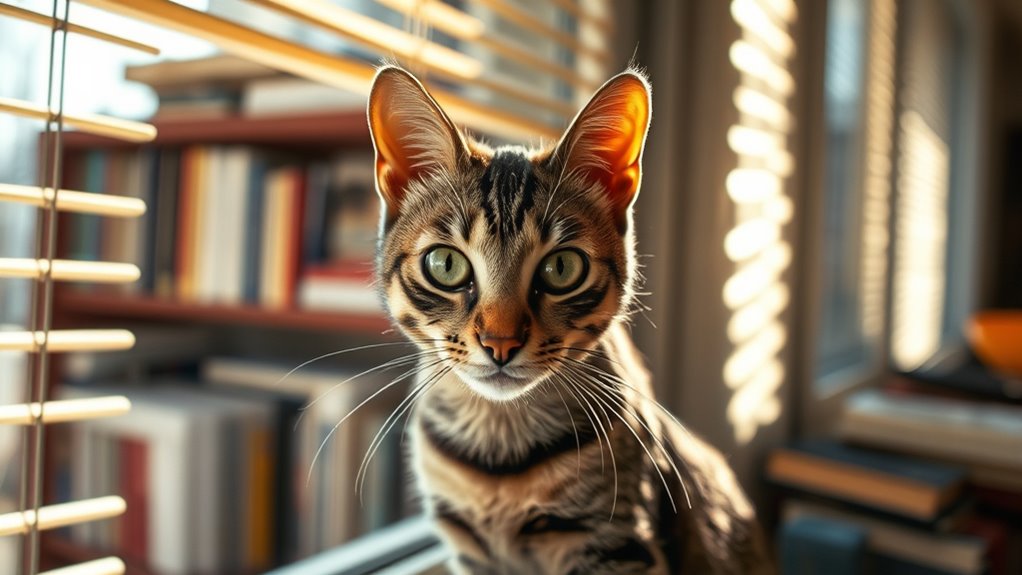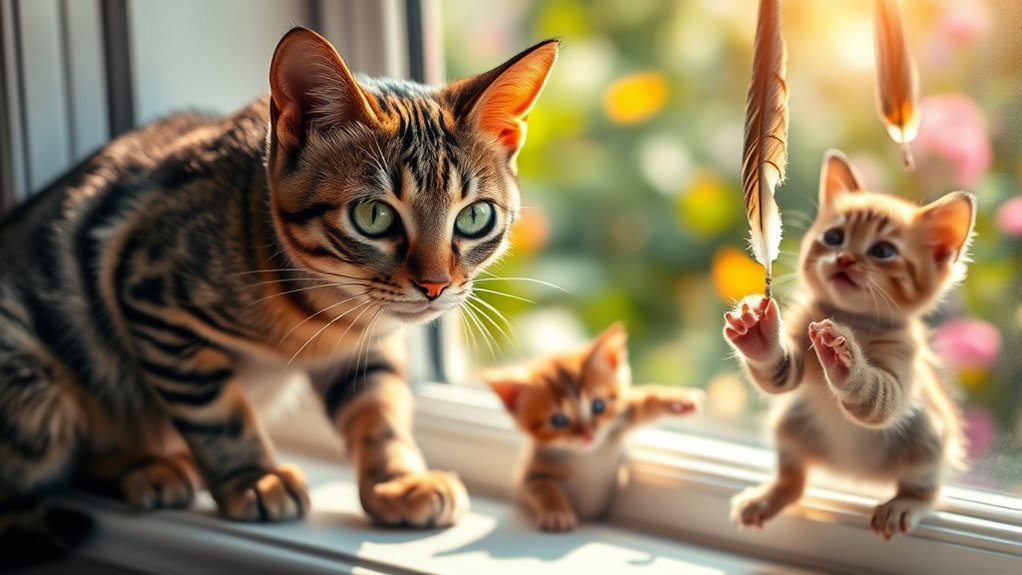Did you know cats communicate with a surprisingly complex mix of sounds, body language, and scent marks that reveal their true feelings? Their purrs can mean contentment, pain, or stress, while tail flicks and eye contact convey different emotions. Evolution has shaped these subtle signals to help cats assert territory, find mates, and interact socially. If you keep exploring, you’ll uncover even more astonishing ways cats express themselves and challenge your assumptions.
Key Takeaways
- Cats communicate a wide range of emotions through subtle signals like tail flicks and eye contact, revealing complex social behaviors.
- Many behaviors thought to be random are actually evolved survival and social communication methods rooted in their evolutionary history.
- Scent marking plays a crucial role in feline communication, helping establish territory and social bonds beyond just visual cues.
- Domestic cats retain instincts from their wild ancestors, influencing behaviors like hunting, marking, and social interactions.
- Understanding feline signals challenges perceptions of independence, showing they are highly social and communicative animals.

Cats are some of the most fascinating animals you can encounter, with quirks and behaviors that often surprise their owners. One of the most intriguing aspects of cats is their ability for feline communication. Unlike dogs, which often rely on vocalizations and overt gestures, cats communicate through a complex mix of sounds, body language, and scent marks. A simple purr can indicate contentment, but it can also be a self-healing mechanism or a sign of discomfort. A flick of the tail might show agitation or curiosity, depending on the context, while their eyes can convey everything from affection to warning. Recognizing these subtle cues helps you understand your feline friend better, revealing a language that’s evolved over thousands of years.
Cats communicate through subtle sounds, body language, and scent marks, revealing a complex language refined over thousands of years.
This brings us to cat evolution, which has played a significant role in shaping how they communicate today. Domestic cats descend from wild ancestors like the African wildcat, and their communication methods have been refined through natural selection. Over time, cats developed nuanced ways to assert territory, find mates, and avoid conflict—all without the need for overt aggression. Their ability to convey complex emotions through minimal gestures is a testament to their evolutionary history. For instance, the way a cat arches its back or twitches its tail can hint at its mood, a skill honed over generations to help them survive in both wild and domestic environments. Understanding their evolution helps you appreciate why they might seem so mysterious or aloof at times; these behaviors are rooted in survival instincts that have been passed down. Additionally, their use of body language for communication reflects their adaptation to social living and environmental challenges.
You might think cats are solitary creatures, but their evolution actually highlights their social intelligence. While they may appear independent, they communicate within colonies or with humans through specific vocalizations and body signals. Their ancestors relied heavily on scent markings and visual cues to maintain social hierarchies and territory boundaries. Modern cats still use scent glands around their face and paws to leave messages in their environment, a behavior that’s directly linked to their evolutionary past. Recognizing this helps you see beyond their often aloof exterior and understand that their communication methods are deeply embedded in their history.
In essence, understanding feline communication and the evolution behind it reveals a creature that’s both complex and highly adaptable. Their behaviors are not random but are the result of thousands of years of evolution, making them uniquely capable of expressing themselves in subtle, sometimes mysterious, ways. When you start to notice these signals, you’ll realize that cats are more than just cute pets—they’re evolutionary marvels with a language all their own, waiting for you to decipher.
Frequently Asked Questions
Do Cats Have Unique Fingerprints Like Humans?
You’re wondering if cats have unique fingerprints like humans. Actually, cat fingerprinting is possible because each cat’s nose-print and paw pad patterns are unique, making feline identification reliable. While we can’t use their fingerprints the same way, these distinctive nose and paw prints serve as effective feline identification methods. So, yes, your cat’s nose and paw pads provide a form of unique identification, much like human fingerprints.
Can Cats Recognize Their Own Reflection?
Imagine your cat staring intently at its reflection, like a detective uncovering a mystery. In feline psychology, cats generally don’t recognize themselves in mirrors; they see a strange cat, not their own reflection. This often leads to cat humor, with cats pawing at or ignoring their image. While some cats may show fleeting recognition, most rely on scent and sound, not visual self-awareness, highlighting their unique perception of the world.
Are Cats Capable of Dreaming?
You might wonder if cats dream, and the answer is yes. During their sleep, cats experience feline REM cycles, which are similar to human dreaming phases. Their sleep patterns include periods of deep rest and lighter sleep, where their brain activity suggests they’re dreaming about daily activities. So, next time your cat twitches or paws at the air, it’s probably dreaming about chasing mice or playing.
What Is the Oldest Recorded Cat Age?
Did you know the oldest recorded cat lived to an astonishing 38 years and 3 days? Ancient feline longevity fascinates many, but historical cat records reveal this incredible milestone. While most cats live around 15 years, this extraordinary feline defied the odds. So, when you ponder the maximum age a cat can reach, remember that history shows some cats surpass expectations, proving their resilience and remarkable lifespan.
Do Cats Have a Sense of Time?
You might wonder if cats have a sense of time. Their cat behavior suggests they do, as they can anticipate routines and become anxious when schedules change. Feline perception allows them to recognize patterns and respond accordingly, showing an intuitive grasp of time passing. While they may not understand clocks, your cat’s behavior indicates a natural sense of timing, helping them navigate daily life with surprising awareness.
Conclusion
Now that you’ve uncovered these surprising cat facts, your perspective shifts, your understanding deepens, and your appreciation grows. You see their independence, their curiosity, their mystery—more than just cute companions. You realize they’re complex creatures, full of quirks and secrets. With this newfound knowledge, you’ll observe your feline friends differently, cherish their uniqueness more, and marvel at their extraordinary nature. Because in knowing more, you see more, you understand more, and you love more.










